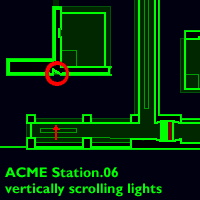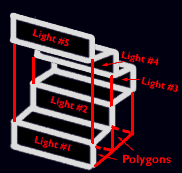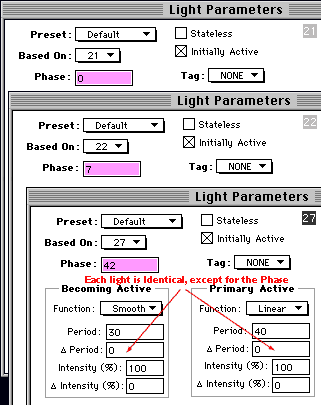 |
 |
 |
|
Acme Station has some
pretty cool lighting effects. The one marked here on the map
is relatively simple to pull off. First, we'll remark on how
the geometry is set up, then we'll go through setting up the
lights. |
|
 |
 |
|
The Polygons
The series of lights scrolling vertically was done by making
a series of very narrow polygons. In this example, there are
four embedded polygons that are wicked narrow. However, the outermost
one doesn't have any high or low sides. The three polygons that
face us have a total of seven (yes hamish) sides. (See the diagram
below to understand what I mean by a facing side.)
The facing sides are the ones that we're going to put lights
on. I mistakenly made the diagram with only two polygons, or
five facing sides (Hamish: two and five equal), but Grendel doesn't
think this will confuse anyone except Grendel.
Setting up the geometry is rather simple: we made the polygons
and then adjusted the floors and ceilings of the polygons so
they "staired" as you look in. We didn't make the polygons
extremely small until the very end of the task, when we turned
off the grid, zoomed in as far as we could go, and adjusted the
positions of the points using the arrow keys on the keyboard.
Keeping the polygons big until the end makes texturing much easier.
|
 |
|
 |
|
On Acme Station we used lights 21-27 for our little trick...
 |
|
The Lights
We created seven lights, and put them out of phase with each
other. The phase of each light was seven more than the previous
light (Ok. I admit it. I like the Number
Seven. It's the best number in the world.). As you can see
the first light has a phase of 0, the second one a phase of 7,
and the last one a phase of 42. So what happens with these lights
is this: the first light starts its cycle at game-tick=0 (there
are 30 ticks in a second). The second one starts at tick 7, and
so on.
Reading over this, the only thing that seems like it might
be confusing is the cycling part. (Go read the manual..) No,
ok. The normal state for a light is when it's cycling between
a primary and secondary mode. If a light gets turned off, it
uses the "becoming inactive" mode and then begins cycling
between the "primary inactive" and "secondary
inactive". Likewise when it turns on again, it uses the
"becoming active" mode, and then the active primary
and secondary cycles. If any of the modes have a period of zero,
that mode is skipped.
In this example, I left out all of the "inactive"
and "becoming" information because none of it is used.
These lights never turn off, on, or anything else.
While we're on the subject, phases don't work for lights that
get turned on or off - or at least I've never gotten them to
work.
|
A Couple of Notes:
If you open Acme Station in Forge, you'll notice that one of the
lines is marked "solid". I think I got really tricky,
and put a transparent texture over this side, to decrease the
depth of the whole do-dad. If you want to mess around in Forge
with this example, I would suggest making that line "not-solid"
and "transparent" because forge has trouble dealing
with transparent sides that are marked solid.
Finally, Grendel was napping while this page was made, so Toolboi
wrote it, but don't worry because Hastur has shown Grendel the
error of his ways.


|






